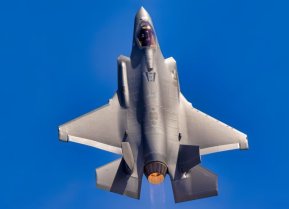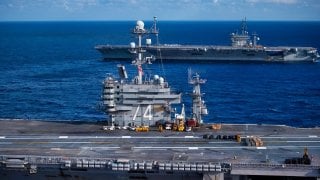Sending Navy Aircraft Carriers to Attack Iran Would Be a Historic Mistake
Summary: Iran's military capabilities are primarily aimed at deterring U.S. military power, especially threatening the strategic deployment of U.S. aircraft carriers and international shipping lanes, crucial for global oil trade.
Summary: Iran's military capabilities are primarily aimed at deterring U.S. military power, especially threatening the strategic deployment of U.S. aircraft carriers and international shipping lanes, crucial for global oil trade. The U.S. Navy's role as a guarantor of maritime security is under direct challenge from Iran's concerted efforts to disrupt this dynamic, illustrating a significant shift in strategic military and geopolitical power balances in the region.
Iran vs. Navy Aircraft Carriers
The Islamic Republic of Iran has been at war with the United States and its allies in the Middle East since the 1979 Islamic Revolution that overthrew the US-supported Shāh and replaced him with the Grand Ayatollah Ruhollah Khomeini. Since that time, the Islamic Republic has been the greatest destabilizing agent in the Middle East. It is the world’s leading state sponsor of terrorism.
As one Saudi official said in 2019, Iran is a “paper tiger with steel claws.” Those steel claws come in the form of the Iranian Revolutionary Guard Corps (IRGC), Hezbollah, Hamas, and the Houthis. Iran’s steel claws are also on display with their growing nuclear program, their increasingly sophisticated ballistic missile arsenal, as well as their anti-access/area denial (A2/AD) capabilities (this is to say nothing of their cyberwarfare abilities).
And as I wrote in my recent book, The Shadow War: Iran’s Quest for Supremacy, since 2019, those “steel claws have been extended.” They are pointed at the soft underbelly of the United States—and their steel claws have been slashing hard against US regional allies, like Israel and Saudi Arabia.
Iran Can Threaten US Aircraft Carriers
Iran, like their partners in China and Russia, understands that America’s conventional military has immense destructive power. So, rather than cower in fear at the prospect of facing the US military, Iran has worked assiduously to build up its own abilities to deter the US military from projecting power into what it views as its sphere of influence. Specifically, Iran is building up their capabilities to prevent the US Navy from deploying its most powerful offensive weapons platform, the aircraft carrier, into regions that Iran views as important to its national interests.
And it isn’t only Iran that is enhancing its A2/AD systems. Iran’s proxies, the aforementioned terror groups of Hezbollah, Hamas, and the Houthis, are all working with Iran to expand their own abilities to hold US Navy warships hostage.
Iran Threatens Global Shipping
We’ve seen this play out to a degree with the Houthis, who have been disrupting international shipping in the Red Sea and the Strait of Bab El-Mandeb. For their part, the Iranians have in the past threatened to obstruct shipping crossing through the vital waterway of the Strait of Hormuz. The Strait of Bab El-Mandeb, and Strait of Hormuz are both part of the United States Department of Energy’s Energy Information Agency (EIA) calls a “world oil transit chokepoint.” The Red Sea is also a critical transit node between other oil chokepoints.
Iran, through its proxies, is now threatening all these conduits of international trade. The US Navy is usually the guarantor of free, open trade on the high seas. That was one of the reasons behind Washington’s decision to deploy its expensive, brand-new Ford-class aircraft carrier off the coast of the Gaza Strip immediately following the dastardly Hamas terrorist attacks on Israel on October 7 of last year.
As the USS Gerald R. Ford deployed to the coastline of Israel and Gaza, another carrier, a Nimitz-class, went around to the Strait of Hormuz. They were a muscular show of force to the region; a signal meant mostly for Tehran to stand down.
Hezbollah Could Have Attacked the Aircraft Carrier U.S.S. Gerald R. Ford
There was real concern among US military planners, however, that Hezbollah, the Iran-backed Shiite terror group in Lebanon, could damage or destroy the American aircraft carrier with their anti-ship missiles (provided by Iran and Russia). This is why the Ford was kept so far off the coast, because navy planners knew the range of those Hezbollah antiship systems.
In the event of war between Iran and the United States, US surface assets, notably the aircraft carriers, will be among the first weapons sent into the fray. And Iranian A2/AD capabilities may be advanced enough to risk the survival of an aircraft carrier. Even if Iranian systems are not technically advanced enough to sink one of America’s gargantuan, complex flat tops, Iran’s forces might be able to seriously damage the all-important flight decks on these great warships, rendering them combat ineffective.
All that Iran would need to do is to damage an aircraft carrier. Such a move would not only blow a hole in our strategic defenses, but it would also force Washington into a defensive position, where they would hold back key assets rather than risk them, meaning that Iran would have the initiative in such a conflict.
Dear Navy: Do Not Use Aircraft Carriers Against Iran
Of course, the US military has other modalities of attack.
Precision missile strikes launched from submarines or air attacks from warplanes launched from one of the countless US military bases in the region are all possible alternatives to the aircraft carrier.
Yet, the Navy insists so often on sending in the flat tops first. This makes sense. It’s not only the ultimate symbol of US military power, but every time it’s deployed it reinforces the supposed justification back home for spending vast sums of tax dollars on such a system. Should that system be knocked out by Iranian (or one of their terrorist proxies) A2/AD weapons, though, it'd shatter the image of invincibility that has long augmented US military power.
The Pentagon cannot underestimate Iran’s threat to its carriers.
About the Author
Brandon J. Weichert is a former Congressional staffer and geopolitical analyst who is a contributor at The Washington Times, as well as at American Greatness and the Asia Times. He is the author of Winning Space: How America Remains a Superpower (Republic Book Publishers), Biohacked: China’s Race to Control Life, and The Shadow War: Iran’s Quest for Supremacy. Weichert can be followed via Twitter @WeTheBrandon.
Image: U.S. Navy Flickr.


